|
|
|
(History taken from the pages of the Script Ohio Book)
In 1878-1879, the Ohio State Marching Band got it's start as a Fife and Drum Corp, consisting of three fifes, eight snare drums, and one bass drum. Their function was to provide background music that ROTC cadets could march to. Later that year, Edward Orton, Jr. gathered toegether every student who could play and instrument, forming the first true band at the University. Under the direction of a student, George D. Makepeace, the band was made up of sixteen members by the Commencement of 1879. Since the band was made up of mostly beginners, much of the rehearsal time was devoted to learning easy music. The band used to practice during winter and spring in the old University Hall. Dressed in regulation military cadet uniforms, the band made its first public appearance at the home of University President Edward Orton, Sr., at a reception he was hosting following the graduation of the class of 1879.
The Ohio State University Marching Band's first director came from a strong military and performing background. Gustav Bruder was accepted into the U.S. Army at the age of 12 and was a member of many distinguished performing ensembles and was offered a cornet position with John Philip Sousa in the U.S. Marines Band.
The OSU Military Department hired Bruder in 1896 and he was immediately faced with the task of organizing a small group of undisciplined bandsmen. The group performed at a variety of functions and in 1899 played its first football game at Ohio Field, travelling later that same season to Michigan to march in six inches of snow. In the years that followed, the band grew to 64 students by 1914, while only accepting first and second year male students. In 1920 the short-lived Varsity Band merged with Bruder's ensemble to create a 100-piece University Band, which sported its first drum major, "Tubby" Essington.
Among Bruder's many accomplishments was the founding of the Grey Baton in 1921, a group formed to create interest in the band. Principal in the formation of the group was Jenie Lee Burke, a bandsman who would lead the transformation of the Grey Baton into the Eta Chapter of Kappa Kappa Psi, the national band fraternity. Burke would go on to become Grand National President of the organization in 1925.
Under Bruder, members tried out for the first time. In 1921, bandmember Elvin A. Donaldson initiated the first formation (O-H-I-O) used by the band. Jenie Lee Burke suggested the acquiring of new uniforms to replace the summer military uniforms, the starting of a School of Music and the furnishing of instruments by the University.
October 21, 1922, was the
dedication of the newly completed Ohio Stadium. In commemoration
of the dedication, each band member was presented with a medal. Changes
occured rapidly from 1922-23. Band members began wearing spats and
pom-pons (plumes) and Elvin Donaldson was appointed Student Director.
In 1924, under Donaldson's direction, the first floating formation appeared.
This started a wave of new band formations in colleges across the country.
White cross belts were added to the uniform during this same year.
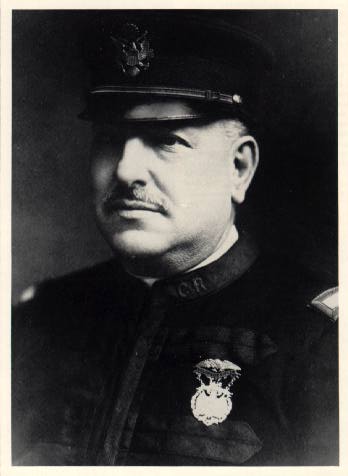 Gustav
Bruder
Gustav
Bruder 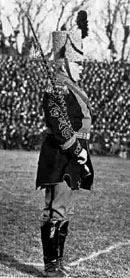 Tubby Essington
Tubby Essington
 Ohio
Stadium under Construction
Ohio
Stadium under Construction
In 1929, a formal agreement was signed by representatives of the Athletic Department, Music Department, and ROTC Department. The Athletic Department would provide the funding for the Marching Band, including money for musical instruments, uniforms, equipment, and trips. The ROTC Department would continue to provide military advisors and academic credit. The Music Department would furnish the staff. That agreement brought Eugene J. Weigel to Ohio State. In addition to taking over the Marching Band, Weigel organized the first Concert Band and also conducted the University Symphony Orchestra. The 1929 Marching Band was comprised only of upperclassmen due to the popularity of the band among students.
In 1930, the band was increased to 120 men, and it remained that size until an expansion program was begun in 1972. Weigel enhanced the band's performance in 1932 by having members completely memorize music before each week's game. By doing this, bandsmen could concentrate more on the marching maneuvers without sacrificing the music.
During his first years with the Marching Band, Weigel changed the uniform hat and revised the ramp entrance to incorporate the herald trumpet fanfare. As many as ten trumpeters would march in front of the band after the entrance and play a special fanfare. The band would follow playing Buckeye Battle Cry as it marched down the field. Weigel is also credited with creating the 8-to-5 marching step, which required bandsmen to take eight steps to every five yards. Up to this time, the military step was a 30-inch step, which provides six steps to every five yards, a step still used by today's band. The 8-to-5 step was accentuated by high leglift, which was more visible thanks to the use of spats.
Fans saw an end to the traditional woodwind, brass, and percussion band at Ohio State when Weigel introduced the all-brass and percussion band on October 6, 1934, at the OSU-Indiana game (OSU 33-7). The new and additional brass instruments provided power and projection. They were especially effective in outdoor settings, such as large football stadiums. Special brass instruments had to be manufactured since there was no demand for them by bands in the United States. Weigel specially ordered ten tenor horns, five B-flat basses, and ten E-flat cornets. Tromboniums were introduced in 1938, replacing the slide trombones. The early '30s also saw halftime shows of new quality and innovations. Humorous themes, new color formations, monograms, and choral singing all added to the magic and charisma of the band.
1936
Weigel introduced the now famous "Script Ohio" at the Pittsburgh game (Osu 0-6) on October 10, 1936, in Ohio Stadium. The band formed a triple block O and continued a follow-the-leader process to form the script O-H-I-O on the field. Drum Major Wesley Leas was the leader. A trademark was established and the most memorable tradition in college band history was begun.
The first field rehearsal produced a big surprise. Weigel's field diagram shows that he planned four choruses of Buckeye Battle Cry to carry the band into the Script formation. As it turned out, he underestimated. Bandsmen who were there recall 22 choruses of Buckeye Battle Cry. The old French March Le Regiment de Sambre et Meuse was transformed into "The Script Ohio Music" and is still used by the band today. Following the march is one chorus of Buckeye Battle Cry, which is sung by the band members and accompanied by the i-dotter. The original i-dotter position, however, was an E-flat cornet, NOT a sousaphone. Over the years, Script Ohio has been transformed and continues to be perfected by bandsmen every day.
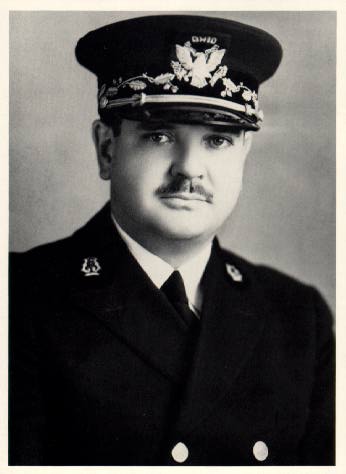 Dr.
Eugene J. Weigel
Dr.
Eugene J. Weigel
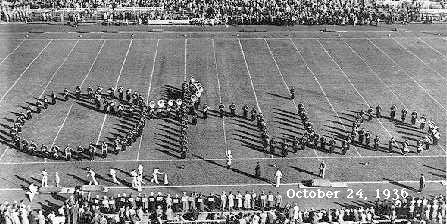 The
very first Script Ohio
The
very first Script Ohio
Replacing Weigel in 1939 was Manley R. Whitcomb. The first major change by Whitcomb involved charting of formations. Previously, Weigel had made only one chart for himself, outlining the formations on the blackboard for the members of the band. Whitcomb charted formations and shows on ditto paper during his first season as director. By using this method, now standard procedure for most marching bands, every bandmember had a copy and could visualize his positions and movements before going onto the field. This procedure saved rehearsal time and enabled the band to learn more complicated formations and maneuvers. Another area of change for which Whitcomb was partially responsible was the WOSU radio program called "Football Fanfare," in which the band would record some of their show music to accompany an interview with the football coach.
 Dr.
Manley R. Whitcomb
Dr.
Manley R. Whitcomb
After Whitcomb entered the Army, William B. McBride accepted the challenge of keeping Marching Band in operation during the World War II years. During this time, most college bands were all male and were forced to fold as their members were called to the Armed Services. Due to McBride's efforts under the most unfavorable conditions, Ohio State was able to field a marching band during the war years. During the 1945 season, band members started musical cheers, but McBride often resented the amount of time spent on the cheers.
 Dr.
William B. McBride
Dr.
William B. McBride
In 1946, Whitcomb returned to direct the band, but the band Whitcomb found upon his return had changed. Many of the members were veterans and more mature (wiser and more experienced) than the typical college student. This was a time for change and updating the band's routines. The military image of most marching bands was altered, especially in the length of the marching step, faster tempo of school songs, and the replacement of military marches with the popular music of the day. Richard Heine, who had done some arranging for the Weigel bands, now began to write extensively for the band. He capatilized on the all-brass sound and contemporary music in his arrangements. A new era begam to unfold yet retaining many of the traditions of the Bruder and Weigel bands.
When Manley Whitcomb decided to leave and the job of leading TBDBITL was vacant, Jack Evans took the job at the urging of Eugene Weigel, and subsequently began a 12-year stint at the helm of the OSUMB.
Until 1960, the marching band practiced in an old stock judging pavilion, dubbed "Rehearsal Hall". When the University's Planning Division came to ask Prof. Evans if he would consider changing quarters to the stadium recreation room, he jumped at the chance and thus began the band's forty year stay in what was named the Stadium Bandroom. (The facility was located in the northwest corner of Ohio Stadium and was used by the band until early 2001.) The new facilities also made convenient two practice fields, one of grass and another of pavement, both located near the stadium.
Numerous changes in band procedures were made during Evans' directorship. He standardized the spacing in formations, replaced the alto trumpets assigned to the third part with flugelhorns and changed the arm swing. The purpose was to give a sharper appearance and more precision to the band. The ramp entrance was modified so that less time was needed to get the band into formation. Also, the heavy West Point overcoats were replaced with cloth raincoats.
The OSUMB made the first of its many commercial recordings on the FSR label under Evans. Volume I was recorded in St. John Arena after the Rose Bowl trip of 1958. The first sound motion pictures of the band were made by the University's Department of Photography and Cinema during Evans' tenure as well. In 1952, the band terminated all formal contacts with the ROTC, "to bring the OSUMB up to Big Ten standards".
Evans also formed the Activities Band shortly after his arrival on campus. This was a second concert band formed primarily for non-music majors. It was later renamed the Buckeye Band. When it reached 130 pieces, it was split-up into two bands: the Buckeye Gray and Buckeye Scarlet bands. In addition to giving campus concerts, the bands also performed at home basketball games.
 Jack
O. Evans
Jack
O. Evans
On the directing staff for seventeen years, Dr. Charles Spohn was responsible for many lasting traditions of the OSUMB. Hang On Sloopy, the official rock song of the State Of Ohio, was first performed in 1965 and became an instant hit with the OSU fans.
Dr. Spohn was always looking for current music to play, as he regularly requested play lists from local radio stations. He emphasized 'lively' shows, as he observed, "After all, the only reason for a band to be at an athletic contest is to be part of the cheerleading process, to provide the spirit."
Dr. Spohn was known for the importance he placed on getting to know his students, as he frequently arrived at the stadium bandroom early to have a "bull session" with whomever was around. This interest led to his idea of organizing a TBDBITL Alumni Reunion (the first was held in 1966). The TBDBITL Alumni Reunion continues to this day as an annual event held at the first home game in September.
Dr. Spohn was awarded the Script Ohio Award by the TBDBITL Alumni Club in 1977, it's highest award given for "Meritorious Service to the Ohio State University Marching Band." Dr. Spohn passed away in 1998.
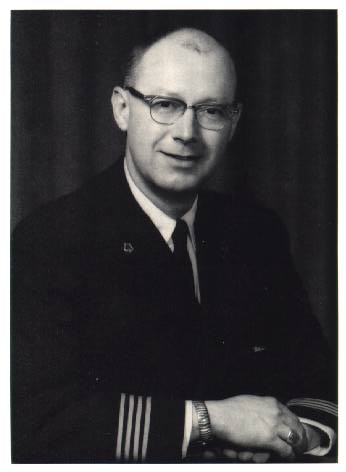 Dr.
Charles Spohn
Dr.
Charles Spohn
 The
Original Hang On Sloopy Step
The
Original Hang On Sloopy Step
Dr. Paul Droste held the Director's position in the OSUMB for 14 years, and is responsible for much of the band's current look and sound. He is also the only director in the history of the OSUMB to have previously been a marching member. He was a member of M Row (baritones) from 1954-1957. One of Droste's first moves was to increase the size of the band, from 120 pieces to 192 over a span of five years (1972-1976). The tuba section was doubled, percussion section expanded to include pitched duo-toms (later to become trio-toms, now quad-toms), and additional rows of trumpets, flugelhorns, alto horns, and tromboniums were added. Droste finalized the band's instrumentation in the early 1980's by implementing the current row structure and replacing tromboniums with slide trombones, which had been absent from the band since 1938.
Dr. Droste pushed the edge of the band's traditional 'military' nature, coming up with several new ideas. These included a spoof show on other Big Ten bands, and a take-off on Hollywood movies with the infamous "SEX" formation, which kept growing bigger and bigger until it covered the entire field (quite risky for 1971 in Ohio Stadium).
Also, because of Title IX of the 1972 Federal Education Amendments (which prohibits gender-based discrimination), women were finally permitted to try out for the OSUMB in 1973. Following tryout week, five women were selected to be members of the 1973 band.
Dr. Droste resigned his position as Director in January of 1984, and remained on the School of Music Faculty until the early 1990s. He still assists with music auditions during the OSUMB's tryout week, and is a liaison between the band and the TBDBITL Alumni Club. Dr. Droste was awarded the Script Ohio Award by the TBDBITL Alumni Club in 1982, it's highest award given for "Meritorious Service to the Ohio State University Marching Band."
Dr. Droste's children, Diana and Doug, have marched in the OSUMB. Doug Droste was a member of B Row and also served as B1. His birth announcement is located in the Script Ohio Book. (heh heh)
 Dr.
Paul Droste
Dr.
Paul Droste  Dr. Droste as a member of the OSUMB
Dr. Droste as a member of the OSUMB
Dr. Woods has been on the directing staff for over 25 years, and has served as full-time Director longer than anyone. He is a nationally known clinician on marching band techniques and show design, and frequently travels around the country serving as an adjudicator for band competitions.
One of his first actions as director was to begin charting formations by computer, making Ohio State one of the first bands in the country to use such technology in the early 1980s. During his tenure as Director, the band was awarded the esteemed Sudler Trophy, and was featured nationally with a full-page feature in the USA Today newspaper.
The instrumentation of the OSUMB has been modified twice during his tenure. In the mid-1990s, Dr. Woods searched the globe for a new Eb alto horn, but few manufacturers produced the alto horn and no models could be found that were suitable for the OSUMB. Therefore, in 1996 both rows of Eb alto horns were replaced with F Horns (also known as 'mellophones'), which are more widely available and have a much brighter sound. In 1999, Dr. Woods added several bass trombones to augment the low-brass sounds of the band. Also in 1999, the trios in the percussion section were replaced with quads, and in 2000, the bass drummers used tonal bass drums for some halftime music, to give the percussion section a more contemporary sound.
Dr. Woods heavily emphasizes recruiting as a tool to maintain the excellence and tradition of the OSUMB, and makes rehearsal discipline and adherence to band policies two of his top priorities.
In February, 2001, the Marching Band moved from their location on the Northwest side of the stadium to a brand new million dollar facility on the Northeast side. The construction of the bandroom spanned approximately 3 years and was aided by a generous $1.5 million donation by the Steinbrenner family. It is, appropriately, named the Joan Zieg Steinbrenner Band Center.
 Dr.
Jon R. Woods
Dr.
Jon R. Woods
We are searching for B Row History. Any alumni out there with some history, please email us at \b_row@musician.org.
|
|
Photos |
Updates |
Personnel |
Alumni |
|
|
|